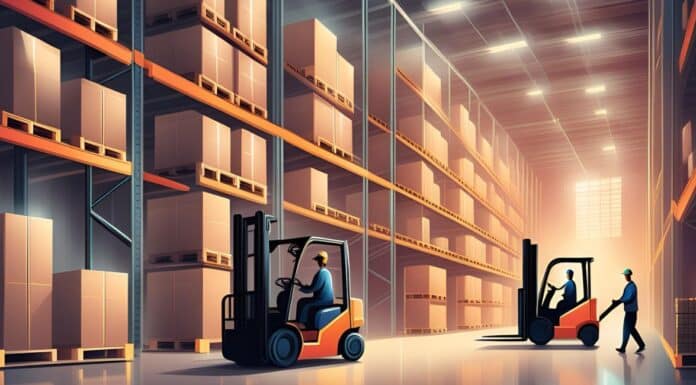Warehouse space optimization is the efficient use of space to store inventory and ensure smooth operations. It involves analyzing layout, storage methods, and workflows to maximize space and improve efficiency.
Warehouse space optimization is a critical component of modern warehouse management. With the rising costs of real estate, particularly in regions like Singapore, efficient space utilization has become more important than ever.
By focusing on strategic warehouse space optimization, businesses can enhance operational efficiency, reduce costs, and ultimately improve profitability.
This article explores essential tips and strategies to help you maximise your warehouse space and achieve optimal performance, with a focus on how a Warehouse Management System (WMS) can play a pivotal role in this process.
Key Takeaways
|
Warning: Undefined array key "med" in /home/hashmicr/public_html/blog/wp-content/plugins/insert-headers-and-footers/includes/class-wpcode-snippet-execute.php(419) : eval()'d code on line 281

What is Warehouse Space Optimization?

Warehouse space optimization refers to the strategic use of available warehouse space to store inventory efficiently while maintaining smooth operational flow. This process involves analyzing the warehouse layout, storage methods, and workflow to identify areas where space can be used more effectively.
The goal is to maximise space utilization without compromising the efficiency and safety of warehouse operations. A Warehouse Management System Singapore (WMS) plays a crucial role in this process by providing real-time data and advanced analytics that help managers make informed decisions about space utilization.
By implementing a well-thought-out space optimization plan, supported by a robust WMS, businesses can accommodate more inventory, streamline operations, and reduce the need for costly expansions.
Understanding the Importance of Warehouse Space Optimization
In the competitive business landscape, effective warehouse space optimisation offers several key benefits:
- Increased Storage Capacity: Optimising warehouse space allows you to store more products within the same footprint, delaying or eliminating the need for costly expansions. With a WMS, you can better track and manage inventory levels, ensuring that space is used efficiently.
- Enhanced Workflow Efficiency: A well-optimized warehouse layout minimises the time and effort required to pick, pack, and ship orders. WMS software can automate the directed put-away process, guiding workers to the best locations for storing items, which in turn reduces travel distances and speeds up operations.
- Cost Reduction: Proper space utilization can lead to substantial cost savings. This includes lower energy costs from heating and cooling less space, reduced labour costs due to more efficient workflows, and savings from avoiding unnecessary expansions. WMS tools help track space usage and identify underutilized areas, enabling more efficient planning and resource allocation.
- Improved Safety and Compliance: Cluttered warehouses with poorly managed space can be hazardous. Effective space optimization, supported by a WMS, helps reduce risks by ensuring that aisles are clear, storage is stable, and all safety regulations are met. A WMS can also automate safety compliance checks and alerts.
- Better Inventory Management: Space optimization often goes hand-in-hand with better inventory management practices. A WMS enables more accurate tracking of inventory, preventing overstocking and understocking, which directly impacts space utilization.
For businesses in Singapore, where space is at a premium, warehouse space optimisation is not just a best practice—it’s a necessity. Utilizing advanced warehouse management system (WMS Singapore) can provide real-time data to help monitor and optimise space utilization continuously.
By investing in a robust Warehouse Management System, you can ensure that your warehouse space is used to its fullest potential, reducing costs and improving productivity.
Many WMS solutions offer flexible pricing schemes to suit businesses of all sizes, with features that include real-time inventory tracking, automated put-away systems, and detailed space utilisation analytics. Click the banner below to explore the pricing schemes and find the perfect solution for your business.
How to Calculate Warehouse Space Utilisation?
Accurately calculating warehouse space utilization is the first step toward effective optimization. This calculation provides insights into how well your space is being used and where improvements can be made. Here’s a detailed approach to calculating space utilisation:
- Measure Total Warehouse Space: Start by calculating the entire floor space of your warehouse, including storage areas, office spaces, loading docks, and aisles. This total square footage represents your available space.
- Measure Used Space: Identify the areas actively used for storing inventory, including shelving, racks, and floor storage. This includes the space taken up by equipment and other fixed installations.
- Calculate Utilisation Rate: The warehouse space utilisation rate is determined using the formula:

A higher percentage indicates better space utilization, while a lower percentage suggests there may be opportunities to optimize. - Analyse and Adjust: Once you have your utilisation rate, compare it against industry benchmarks. A well-optimized warehouse typically has a utilization rate between 80% and 90%. Anything higher may indicate overcrowding, while lower rates suggest underutilized space.
By integrating a WMS into this process, you can automate the calculation and analysis of space utilization, making it easier to identify inefficiencies and implement corrective actions.
Regularly monitoring and adjusting your warehouse space utilization helps you stay responsive to changes in inventory levels and operational demands, ensuring continuous efficiency.
10 Strategies to Maximise Warehouse Space Optimization

Effective warehouse space optimization is essential for businesses that aim to maximise productivity, reduce costs, and make the best use of their available space. With proper strategies in place, your warehouse can operate more efficiently, ensuring a smoother workflow and increased storage capacity without the need for expansion.
The following ten strategies focus on key areas that can help you unlock the full potential of your warehouse, from layout adjustments to implementing advanced technology like warehouse management systems (WMS).
1. Utilise Vertical Space
To maximise space, consider using vertical storage options. Installing taller shelving units and mezzanines allows you to store more products without expanding your warehouse’s footprint.
Vertical storage is especially effective for items that do not require frequent access. A WMS can help track inventory stored at higher levels, ensuring easy retrieval when needed. Additionally, barcode tracking software enhances the accuracy of inventory management in vertical storage by making it easier to locate and scan products, reducing retrieval times.
2. Reduce Aisle Widths
Narrowing aisle widths can free up significant space for additional storage. While this strategy may require the use of specialized narrow-aisle forklifts, the increased storage capacity often justifies the investment.
However, safety should never be compromised, so it’s essential to ensure that your equipment and layout still meet all safety standards. A WMS can optimize the placement of items in these narrower aisles, ensuring that frequently picked items are easily accessible.
3. Optimise Warehouse Layout
A well-designed warehouse layout is crucial for effective space optimization. This involves arranging storage units to minimize travel distances for workers and streamline the flow of goods through the warehouse.
Consider implementing a U-shaped layout, which optimizes space by having a single, continuous flow of goods from receiving to shipping. A WMS can simulate different layout configurations to determine the most efficient design.
4. Implement Directed Put-Away Systems
Directed put-away systems, often managed through a WMS, ensure that inventory is placed in the most efficient locations based on size, weight, and turnover rate. This approach reduces the amount of wasted space and improves overall space utilization.
By automating this process, a WMS eliminates guesswork and maximises the efficiency of your storage strategy.
5. Incorporate Mezzanines
Mezzanines are a cost-effective way to add storage space without expanding your warehouse. By installing a mezzanine level, you can effectively double the usable space for certain areas, such as packing stations or offices, freeing up more ground-level space for storage.
A WMS can track inventory stored on mezzanines, ensuring it is managed as efficiently as inventory stored at ground level.
6. Adopt High-Density Storage Solutions
High-density storage systems, such as drive-in or push-back racks, allow for more inventory to be stored in a smaller area. These systems are ideal for storing large quantities of similar items, though they may require more complex inventory management to ensure easy access to products.
A WMS can help manage these high-density systems, tracking inventory locations and streamlining the retrieval process.
7. Regularly Review Inventory Levels
Maintaining optimal inventory levels is essential for space optimisation. Regularly reviewing inventory can help identify slow-moving or obsolete stock that can be cleared out to free up space.
Seasonal inventory management strategies, such as stocking up before peak periods and clearing out afterwards, can also help maintain efficient space utilization. A WMS provides real-time insights into inventory levels, helping you make data-driven decisions.
8. Maximise Overhead Space
Overhead space is often underutilised in warehouses. Installing additional shelving above work areas or in unused corners can provide extra storage for less frequently accessed items, such as spare parts or seasonal products. A WMS can track these items, ensuring they are easily located when needed.
9. Utilise Temporary Storage Solutions
During peak seasons or times of unexpected demand, temporary storage solutions, such as portable storage units or renting additional warehouse space, can provide the extra capacity needed without a long-term commitment.
These solutions offer flexibility and can be scaled up or down as needed. A WMS can manage these temporary solutions, ensuring that inventory stored off-site or in temporary locations is accurately tracked.
10. Leverage Technology
Advanced warehouse management system (WMS Singapore) is invaluable for space optimization. These systems provide real-time data and analytics on inventory levels, space utilization, and workflow efficiency, enabling you to make informed decisions that optimize your warehouse operations continuously.
The integration of a WMS allows for automation in many areas, from inventory management to space optimization, making your warehouse more efficient and responsive to changing demands.
For more information, check out other articles that focus on optimizing bonded warehouse operations and maximizing capacity.
Conclusion
Warehouse space optimization is an ongoing process that requires careful planning, continuous monitoring, and the right tools.
By implementing the strategies discussed in this article, and leveraging the capabilities of a robust Warehouse Management System (WMS), you can maximise your warehouse space utilization, enhance operational efficiency, and reduce costs.
Whether you’re managing a large distribution centre or a smaller warehouse, these tips will help you make the most of your available space. Incorporating technology, such as WMS, into your space optimization efforts will further enhance your ability to manage space effectively, ensuring that your warehouse operates at peak efficiency.
In a market where space is at a premium, particularly in Singapore, effective warehouse space optimization supported by a WMS is essential for staying competitive and ensuring long-term success. To achieve these goals, consider leveraging the advanced features of HashMicro’s Warehouse Management System.
Designed with the needs of businesses in Singapore in mind, HashMicro’s WMS offers comprehensive tools that allow you to optimize warehouse space, streamline operations, and improve inventory accuracy.
With its intuitive interface and powerful analytics, you can gain real-time insights into your warehouse operations, helping you make data-driven decisions that boost efficiency and reduce costs. Want to experience the benefits firsthand? Try our software with a free demo today! Click the banner below to get started.
Warning: Undefined array key "med" in /home/hashmicr/public_html/blog/wp-content/plugins/insert-headers-and-footers/includes/class-wpcode-snippet-execute.php(419) : eval()'d code on line 281

Frequently Asked Questions
-
What is space optimization?
Space optimization involves using available workspace efficiently. It focuses on utilizing underused areas through informed decisions to boost utility, productivity, and cost-effectiveness.
-
How do you plan a warehouse space and layout?
Planning a warehouse layout involves several steps:
1. Define the warehouse’s purpose: Determine the primary operations, such as storage, shipping, or receiving.
2. Create a diagram: Sketch the layout and calculate total storage space.
3. Consider storage needs: Identify the types of products and storage systems required.
4. Evaluate equipment: Assess material handling equipment necessary for efficiency.
5. Optimize space: Plan the layout to maximize space use and streamline workflows.
6. Test traffic flow: Ensure smooth movement of personnel and goods.
7. Implement the layout: Execute the plan and make adjustments as needed. -
How can a warehouse increase storage capacity?
A warehouse can increase storage capacity by implementing vertical racking systems, which allow more goods to be stored at height. Additionally, optimizing floor space through high-density storage solutions, such as reducing aisle widths, helps accumulate more products in the same area, making the most of every square meter.
{
“@context”: “https://schema.org”,
“@type”: “FAQPage”,
“mainEntity”: [{
“@type”: “Question”,
“name”: “What is space optimization?”,
“acceptedAnswer”: {
“@type”: “Answer”,
“text”: “Space optimization involves using available workspace efficiently. It focuses on utilizing underused areas through informed decisions to boost utility, productivity, and cost-effectiveness.”
}
},{
“@type”: “Question”,
“name”: “How do you plan a warehouse space and layout?”,
“acceptedAnswer”: {
“@type”: “Answer”,
“text”: “Planning a warehouse layout involves several steps:
1. Define the warehouse’s purpose: Determine the primary operations, such as storage, shipping, or receiving.
2. Create a diagram: Sketch the layout and calculate total storage space.
3. Consider storage needs: Identify the types of products and storage systems required.
4. Evaluate equipment: Assess material handling equipment necessary for efficiency.
5. Optimize space: Plan the layout to maximize space use and streamline workflows.
6. Test traffic flow: Ensure smooth movement of personnel and goods.
7. Implement the layout: Execute the plan and make adjustments as needed.”
}
},{
“@type”: “Question”,
“name”: “How can a warehouse increase storage capacity?”,
“acceptedAnswer”: {
“@type”: “Answer”,
“text”: “A warehouse can increase storage capacity by implementing vertical racking systems, which allow more goods to be stored at height. Additionally, optimizing floor space through high-density storage solutions, such as reducing aisle widths, helps accumulate more products in the same area, making the most of every square meter.”
}
}]
}













